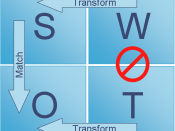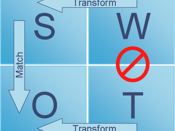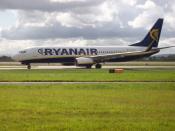Contents1. Background22. Theoretical framework33. SWOT analysis of Ryanair44. Challenges and recommendations for the future75. References81. BackgroundThe subject of this report is Ryanair - the first Low Cost Carrier in Europe - which was founded in 1985 (Ryanair.com History 2008). The firm began operations with a staff of 25 and a single 15-seat airplane flying between Waterford and London. In 1986 Ryanair received permission to begin flying four flights a day on the Dublin-London route. In doing so, they challenged the monopoly of British Airways and Aer Lingus with fares that were much lower. Ryanair's strategy was to offer simple, low-cost fairs and exemplary customer service. During the later part of the 80s Ryanair continued to compete vigorously with British Airways and Aer Lingus while adding additional routes and airplanes (Creaton 2004). In 1990 Ryanair suffered a ã20 million loss and was forced to completely restructure. A new CEO - Michael O'Leary - was charged with making the airline profitable.
He visited the USA to study the 'low fares/no frills' model being used by Southwest Airlines. O'Leary quickly decided that the key to low fares was to implement quick turn-around times for aircraft, "no frills", and no business class, as well as operating a single model of aircraft (Ryanair About Us n.d.). Despite the decline in overall airline traffic, Ryanair made a profit of ã293,000 for the year and carried 651,000 passengers.
In 1997, the EU air transport deregulation allowed the airline for the first time to open up new routes to Continental Europe with over 3 million passengers on 18 routes carried. Ryanair launched services to Stockholm, Oslo, Paris and Brussels and started to float Ryanair plc on Dublin and NASDAQ Stock exchanges. In 2000, they announced the launch of 10 new European routes for the summer and the company...


